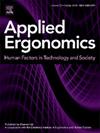Influence of compression stockings with different compression classes on lower leg edema and perceived discomfort during a two-hour static standing exposure – a pilot study
IF 3.4
2区 工程技术
Q2 ENGINEERING, INDUSTRIAL
引用次数: 0
Abstract
Lower leg edema (LLE) is considered a surrogate-parameter for stress on the venous system in situations with venous hypertension such as standing at work. Therapy with medical compression stockings (MCS) is well-established in chronic venous insufficiency (CVI) patients for reducing venous pressure. It remains unclear though to what extent increased levels of LLE related to prolonged standing can be diminished by MCS in healthy individuals as well as CVI patients. This paper investigated to what extent wearing MCS class I (CCL I) and II (CCL II) reduces LLE and rating of perceived discomfort (RPD) during prolonged standing among both healthy subjects (n = 32) and CVI patients (n = 12) and how wearing comfort differs between classes. This randomized cross-over trial had three conditions: two-hour standing without MCS, with CCL I (18–21 mmHg), with CCL II (23–32 mmHg). LLE was quantified using waterplethysmography and bioelectrical impedance. RPD was assessed using an 11-point Likert scale. Wearing comfort was assessed using a self-developed questionnaire. Wearing MCS statistically significantly reduced LLE in healthy subjects and CVI patients, with least edema development after wearing CCL II. RPD was reported mainly in the lower-back after two hours (mean 0.9). Wearing comfort was rated slightly better for CCL I. Healthy subjects and CVI patients who spend large parts of the day standing can decrease LLE by wearing MCS, of which CCL I may lead to better long-term compliance.
在两小时的静态站立暴露中,不同压缩等级的压缩袜对下肢水肿和感觉不适的影响-一项试点研究
下肢水肿(LLE)被认为是静脉高压情况下静脉系统压力的替代参数,如站立工作。医用加压袜(MCS)治疗慢性静脉功能不全(CVI)患者降低静脉压的方法已得到证实。目前尚不清楚MCS能在多大程度上降低健康个体和CVI患者与长时间站立相关的LLE水平升高。本文研究了在健康受试者(n = 32)和CVI患者(n = 12)中,佩戴MCS I类(CCL I)和II类(CCL II)在多大程度上降低了LLE和长时间站立时感知不适等级(RPD),以及不同类别之间佩戴舒适度的差异。这项随机交叉试验有三种情况:无MCS站立2小时,CCL I (18-21 mmHg), CCL II (23-32 mmHg)。采用水容积脉搏图和生物电阻抗定量LLE。RPD采用11分李克特量表进行评估。穿着舒适度采用自行编制的问卷进行评估。在健康受试者和CVI患者中,佩戴MCS在统计学上显著降低LLE,佩戴CCL II后水肿发展最少。RPD主要发生于2小时后的下背部(平均0.9)。健康受试者和一天中大部分时间站立的CVI患者可通过佩戴MCS降低LLE,其中CCL I可导致更好的长期依从性。
本文章由计算机程序翻译,如有差异,请以英文原文为准。
求助全文
约1分钟内获得全文
求助全文
来源期刊

Applied Ergonomics
工程技术-工程:工业
CiteScore
7.50
自引率
9.40%
发文量
248
审稿时长
53 days
期刊介绍:
Applied Ergonomics is aimed at ergonomists and all those interested in applying ergonomics/human factors in the design, planning and management of technical and social systems at work or leisure. Readership is truly international with subscribers in over 50 countries. Professionals for whom Applied Ergonomics is of interest include: ergonomists, designers, industrial engineers, health and safety specialists, systems engineers, design engineers, organizational psychologists, occupational health specialists and human-computer interaction specialists.
 求助内容:
求助内容: 应助结果提醒方式:
应助结果提醒方式:


